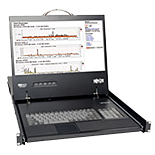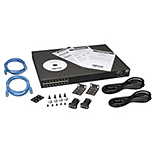KVM switches and console servers are both powerful tools for any data center or network closet, but their similar function often causes confusion. To put it in simple terms, there are two main differences between these devices:
- KVM switches can control PCs and servers, while console servers can control other serial and network-connected devices.
- KVM switches can only switch between the connected network devices, but console servers can access the system consoles of network devices to monitor and control their functionality.
Let’s take a closer look at the distinction between these two network management tools.
KVMs: Ideal for Server Control from the Same Room or from Across the Globe

A KVM switch is a device that allows you to control and access multiple computers or servers using a single keyboard, video monitor and mouse. KVMs are frequently found in data centers where there are multiple PCs and servers, with no need for a dedicated keyboard, monitor and mouse for each. A KVM switch is frequently used to manage file servers, domain servers, print servers and blade servers.
Local KVMs connect to the devices they control using Cat5/6 patch cables or special KVM cable kits. A keyboard, monitor and mouse are then connected to the KVM switch. Many KVM switches, such as Tripp Lite’s B040-008-19, include a built-in, foldaway keyboard, monitor and touchpad, all contained within a rack-mount console that occupies only 1U of rack space. The connected computers/servers are controlled through buttons on the KVM, on-screen display controls or hot keys on the keyboard.
A KVM switch equipped with serial- or network-connected IP access is called an IP KVM switch. It allows the user to manage connected devices from anywhere in the world via LAN, WAN or the Internet. The NetCommander® B070-016-19-IP from Tripp Lite is an example of a 16-port IP KVM switch that provides efficient remote access.
Some KVM switches allow multiple users to manage multiple devices simultaneously. Multi-layer password security enables an administrator to create levels of access to various users. For example, Tripp Lite’s B070-008-19-IP allows set-up of administrator accounts with full access and user accounts with limited access, plus advanced security features such as unsuccessful login blocking and idle timeout.
Console Servers: Access All Network Devices Wherever You Are

In contrast to a KVM switch, a console server provides access to “headless” devices, that is, network components with no display, keyboard or mouse, such as firewalls, PBX systems, uninterruptible power supply systems, power distribution units, remote power control units, routers, storage systems and switches.
Like an IP KVM switch, a console server gives you the ability to access and control network devices from anywhere in the world using an Ethernet connection or a dial-up serial port/modem connection, in conjunction with a terminal emulator program. Some console servers have built-in modems to support cellular access for increased system availability. Certified for use on Verizon’s cellular network, Tripp Lite’s B094-008-2E-V features a built-in modem that supports 4G LTE speeds.
RJ45 ports provide direct connection to serial devices without the need for an adapter. Secure tunneling connections allow multiple concurrent users to access hundreds of devices through a single IP address. Tripp Lite’s B096-048 offers 48 RJ45 ports for connecting serial devices, along with a host of other advanced features to meet the requirements of the most demanding data center.





